Hong Kong is a group of islands off the Southern coast of China and enclaved by the South China Sea. It is a special administrative region of China which essentially means it is ultimately part of China but has certain legislative and regulatory autonomous permissions. In other words it just about governs itself somewhat independently from Beijing.
Having been to mainland China I can see stark differences between Hong Kong and its parent. Freedom of speech and independence of media is perhaps one of the main differences. There is no censorship in Hong Kong (when I was in China I couldn’t view Facebook and the BBC for example) but importantly, and perhaps one of the reasons that Hong Kong is a global city dominated by international banks and financial institutions, is that international companies are treated exactly the same as homegrown corporations and business is done in English. In other words if for example the Bank of America took HSBC (Hong Kong Shanghai Banking Corporation) to court both would get fair representation under the same piece of legislation. Throw into the mix a tax free economy, zero VAT and low income tax and it isn’t hard to see why this autonomous nation is a magnet for global business and as such has cemented itself as one of the power houses of world cities on par with the likes of London, New York, Singapore and Tokyo.
With one of the highest life expectancies in the world, superb healthcare, world leading education, welfare and housing support systems – Hong Kong is leading the way for quality of life and is the current and repeated holder of the best global city for business with many claiming Hong Kong to be the best place in the whole of Asia.
Inhabited since the Stone Age Hong Kong has changed hands plenty of times through its 6000 year history. A sweeping historical lesson is that from around 4000BC fishermen and nomads populated Hong Kong Island until being taken over by the Chinese in 214BC. The Portuguese rocked up in 1557 and claimed neighbouring island Macau their own, French and Dutch followed suit until finally the Ming Dynasty took control in 1644 until being overthrown by the Qing dynasty. Over the next couple of centuries the British created strong opium trading links in Hong Kong and it essentially became the gateway to Asia (Hong Kong having a vast harbour) Over time the Chinese become addicted to opium and the Chinese mainland suffered economically as locals decided to get high rather than go out. In 1799 opium is banned within the country which pisses off the British stationed in India. It kicks off and after an opium war British Marines plant the Union Jack in Hong Kong assuming control in 1841. China, seeing Hong Kong as little more than a tiny harbour hands control to Britain just a year later. The odd coup is attempted over the next 50 years and finally on the 1st July 1898 China officially leases Hong Kong to the United Kingdom for a 99 year period. Immigrants flowed into Hong Kong from China all keen to grab a slice of British freedom and rule and the population steadily increased. However in 1941 the Japanese temporarily take control of Hong Kong until control is regained by the British. The overseas territory flourished and became the main entry point of cargo into and out of Asia. With the British also occupying the second biggest port of entry (Singapore) times were good and the money started to flow beyond peoples wildest dreams. In 1982 China got a sniff of what was going on and so decided they wanted Hong Kong back. Thatcher was having none of it and the territory remained British right up until it was handed back to the Chinese in 1997. In the decade prior to the hand over legislation was put in place that would in some way protect the sovereignty of Hong Kong. And in many ways it has, for example on the mainland a family can only have one child. China operates a forced abortion policy and those circumventing the requirements of termination are heavily fined. Yet Hong Kong operates a three child policy – Traditionally each family should have one boy and so statistically if you have three children one will be a boy.
Naturally Hong Kong’s child policy has caused great concern and so heavily pregnant women were banned from entering the region from the mainland in an attempt to curtail the process of Chinese mothers having their child in Hong Kong and so claiming citizenship.
Whilst researching Hong Kong I found that opinions were polarised, in monetary terms the country is very expensive with real estate being some of the most expensive in the world and despite government subsidies people are struggling with a 5% unemployment rate across some 7 million inhabitants. Inflation has risen an astonishing 16% in the past few years and many agree that despite claims of independence from the mainland the Chinese government is having an increasingly dominant say in the countries affairs and legislature. Still, separated by a sliver of ocean, having its own currency and identity Hong Kong pushes forward as the global force it has perfected over the last half century and so as far as we were concerned it has been on my radar for a while.
The issue with Hong Kong was invariably cost and location. It is out of the way of anywhere and so I toyed with making it part of a bigger China trip, but ultimately settled on making it a joint effort between Hong Kong and Macau dedicating a week shared between both regions. Completely priced out of Macau, with accommodation being in the region of £80 per night it became a heavy ended venture to Hong Kong with a touch of Macau somewhere along the line.
Hong Kong for us almost didn’t happen, right up until a week after we had left I was contemplating changing it for Thailand or perhaps Vietnam. Accommodation was hard to swallow and I knew costs would quickly spiral, or that our budget wouldn’t allow for the time allocated. With hotels coming in at £30 a night for literally a bed that would elsewhere cost £3 it took a lot of effort and time driving down costs I knew we couldn’t escape and it took over.
Still, as our Air Asia Philippines flight soared across the South China Sea through pristine blue skies I felt a tinge of excitement. The kids couldn’t wait after I had given them a run down of what we were doing. Jack was just excited to be going to China and he didn’t really care much other than that fact. Still, it took some hard core negotiation skills for him to comprehend and believe me that the Great Wall of China wasn’t in Hong Kong.
We arrived into the recently voted ‘worlds best airport’ after a 2 hour flight which got ridiculously bumpy as we landed onto the man made island that is home to HKIA.
I am not an airport buff but like a beer I do know the difference between a snide one and a decent one and I knew things were going to be slick from here on in, and I was right. Every thing was smooth and we were stamped in visa free for 180 days.
It was about 9am and so we grabbed some breakfast and a very important black coffee and I sat down and assess what happened next since we had no bed for the night and I hadn’t figured out how we get from the airport to the city.
It is really well connected and you can take a taxi, express train or bus, with the bus being the cheapest option.
The rock bottom cheapest way is to catch the A21 headed to Kowloon which costs just $21 HKD (£1.80) with kids half price. There isn’t a single bus in Hong Kong that gives change and so if you don’t have the correct amount there is a ticket booth at the entrance to the bus station selling tickets.
The bus has wifi and officially takes between 45 minutes and 90 minutes to reach Kowloon, in our instance it took around 50 minutes but was a great initiation to the city and the traffic.
Loosely Hong Kong can be split into 4 regions.
Hong Kong Island – Initially this is where all the money is, its the financial heartland and with its own soho and tonnes of boutique shops completely sap tourists and locals alike of every penny they have. It is teaming with sky scrapers and part of one of the most stunning skylines in the world.
But step back from the dominant buildings and you will find natural Hong Kong. Mountains and temples, the island is a mixture between old and new and encompasses everything in between. With annual investments of $1.6 trillion the city is a furnace of modernity yet within 20 minutes you can be amongst temples and quaint locals behaving like it is the 1800’s. Step a little further south and you will find pristine mountains, beaches and some of the best treks in Asia.
Kowloon – Colonial Hong Kong at its best, leafy and urban Kowloon is a myriad of malls, restaurants and hotels all spanning off legendary Nathan Rd. With some of the best nightlife and cheapest beds in the territory it is the pulsating heart of Hong Kong. The notorious Chungking mansion and Mirdor Mansion both adorn a piece of the southern end of Nathan Rd and should be the first port of call for any backpacker. With every floor offering up guesthouses with rooms no bigger than a cupboard it is probably the most you will ever pay per sq foot for a room. But real estate in Hong Kong is rocketing with the guesthouse I am currently staying in (9 rooms) coming in at a cool $15 million HKD (£1.3 million) If you want Hong Kong on a budget, if you want fake Rolex watches combined with Dior and Luis Vuitton stores then Kowloon should be the first place you head. It is also home to the world famous Star Ferry pier.
New Territories & Outlying Islands – Most visitors to Hong Kong never make it this far, but they behold a tormented history and Chinese life that is almost unique. With stunning green scenery, monasteries and bird watching the New Territories and Outlying islands serve up natural Hong Kong for nature lovers and those looking for life on the quiet. If an unfettered piece of a global city is your thing then this is where you will likely be heading.
Turning up at Kowloon we struggled at first to find a bed for the night, eventually we settled on a box room that genuinely would not have fitted my own king size bed in it. At $350 HKD (£30) for the night it was expensive. My advice is without a doubt – Book ahead. The Holiday Inn next door was asking $2500 HKD per night (£210) and that is considered reasonable.
Like we usually do, we went exploring and since we were at the far southern end of Nathan rd we headed to the harbour. Hong Kong harbour is without doubt the most famous in the world and one of the biggest. It is massive, but oddly discreet. And we walked along the avenue running parallel to the sea. It houses the science museum, arts museum and space museum and then extends along the avenue of stars. The Avenue of stars is literally a walkway with stars of famous people and their handprints. From the likes of Chinese actors like Chow Yun Fat, Jet Li, Jacki Chan and the legendary Bruce Lee.
We spent our afternoon getting free hugs.
Doing Kung Foo by the Bruce Lee statue.
Admiring the view.
Walking the streets.
And then returned at night to see the best skyline in the world illuminated.
Getting to Hong Kong was slick and almost effortless. But I knew, despite the fun I anticipated, keeping a grip on a spiralling budget was going to be much harder than I had originally planned.
Walking back up Nathan rd and trying to nab a bit of air conditioning flowing from the many stores I wondered if I had made the right decision coming here. I looked at the kids for a bit of reassurance and noticed them all doing flying kicks and karate chops and I laughed to myself that of course Id made the right decision.
How could coming to Hong Kong ever be anything but a great decision!

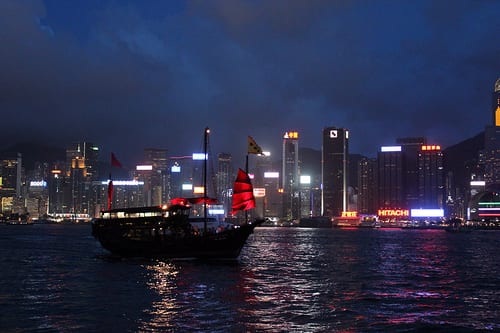
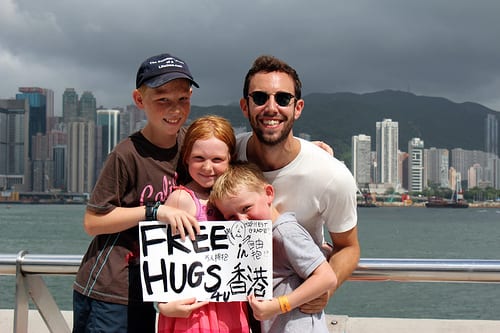
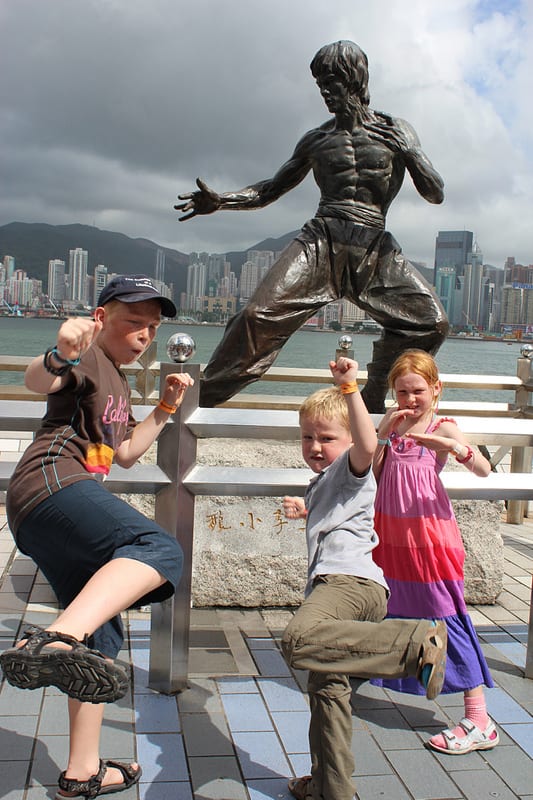
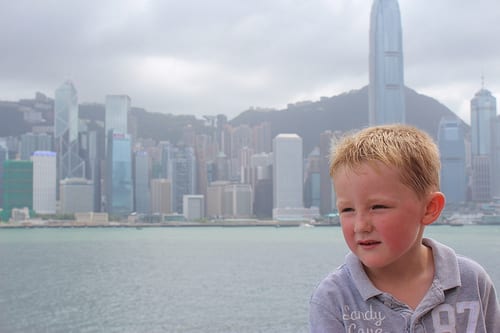
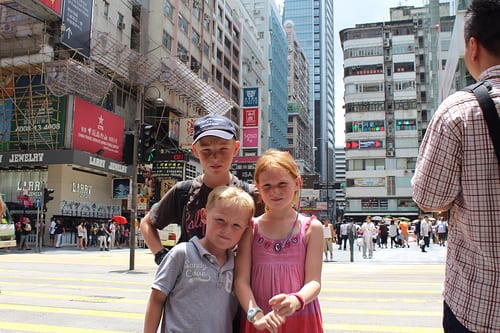
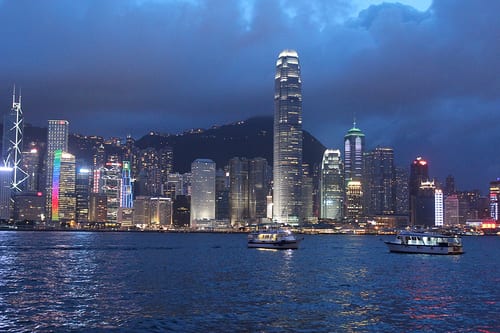
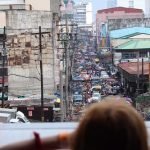
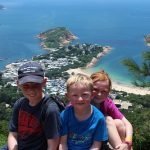
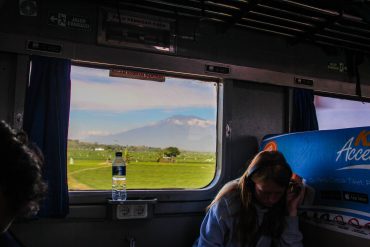
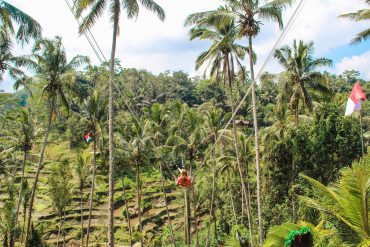
Comments are closed.